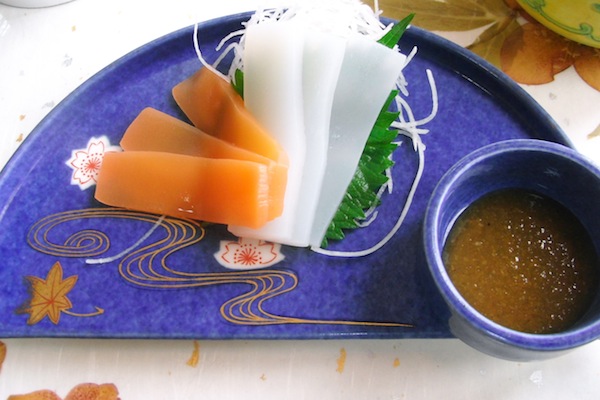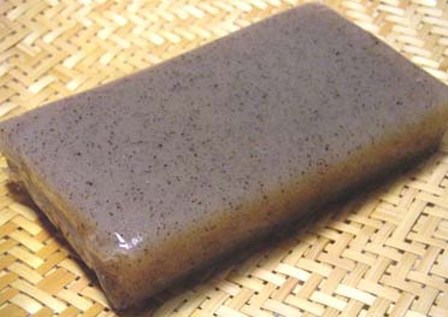Glucomannan, from konjac root, is a form of beneficial soluble fiber that can improve bowel health, blood sugar and lipids, and other health conditions. It can also help you lose fat and stay lean by improving satiety and appetite hormones.
To lose fat, you have to eat less. Simple enough. But it’s hard to get enough fiber when you’re eating less food. Inadequate fiber often means more hunger. More hunger means you want to eat more.
What to do?
Glucomannan, a soluble fiber from konjac root, may be one supplement that meets both these needs — adequate fiber plus greater satiety. It may have many other health benefits too.
What are soluble fibers?
Soluble fibers are a form of so-called “complex” carbohydrate (which means that their more elaborate molecular structure is harder for our bodies to break down) that are soluble in water. In liquid, soluble fibers form viscous gels. For instance, fruit pectin is used to thicken jams and jellies, while xanthan gum is used as an emulsifier that makes foods creamier.
Soluble fibers are also great bacteria food (which earns soluble fiber the term prebiotic). Our gastrointestinal bacteria eagerly ferment soluble fibers, creating byproducts such as valuable nutrients or not-so-desirable gases.
Soluble fibers are found in foods like:
- beans and legumes
- grains such as oats, rye, and barley
- some fruits such as plums/prunes, apples, pears, berries, and bananas
- some vegetables, such as the onion family; the brassica family; and Jerusalem artichokes (root vegetables/tubers are often high in soluble fibers)
- some seeds, such as chia and psyllium
For more on this, see All About Fiber.
From konjac root to glucomannan
Like many tubers, the root of the konjac plant (Amorphophallus konjac) is high in soluble fiber. This soluble fibre is used to manufacture glucomannan (GM) supplements.

Konjac also appears in East Asian cuisine, often as shirataki noodles or a gel that is cut up and served with dipping sauce. It’s generally prized for its gelatinous texture rather than taste, and takes on the taste of whatever it’s cooked, marinated, or dipped in.

From konjac, manufacturers can produce flour or powder, along with “foods” such as noodles, gels, and even candies (although these aren’t recommended for consumption).
What does glucomannan do?
Although konjac has long been used in China, Japan and South East Asia as a food source and as a traditional medicine, Western researchers have only been interested in GM’s health benefits since about the 1980s.
Absorbs water
Glucomannan/konjac flour or powder is highly absorbent, and can suck up tremendous amounts of liquid. In an article on glucomannan, T-Nation included a video showing just how much a wee bit of GM expands when water is added.
Helps us feel fuller, longer
Because it can hold so much water and form a gel, GM helps us feel more satisfied with meals. This means we can eat less but feel more satisfied for longer. Eating less means fat loss.
Studies looking at adding GM to calorie-restricted diets have consistently found that GM groups lose more fat than the non-fiber’d up groups. In one study (Birketvedt GS, et al. 2005), the GM group dropped an additional .8/kg (1.75 lb) on average over 5 weeks compared to the control group.
This effect of feeling full is not necessarily obvious — having a full gut does not always leave one feeling satisfied. As many dieters know, a stomach that’s simply stretched (e.g. from being full of water) doesn’t necessarily result in a lack of desire to eat more. “Mechanical” fullness doesn’t always mean “real” satisfaction.
However, a study of people with Type 2 diabetes (Grill 2010) showed that key hunger signals (such as ghrelin) decreased after taking a meal with GM in it. GM seems to trip sensors in the gut/brain to tell them that less food is more satisfying.
Better carbohydrate tolerance & lipid profile
Along with its effects on physical fullness, GM may improve satiety and fat loss by improving our blood sugar and lipid profile.
One review (Keithley and Swanson 2005) found that 2-4 g of GM each day enhanced dieters’ weight loss efforts, along with other positive side effects like improved blood lipids, carb tolerance, and satiety. Being better able to handle starchy carbs means better insulin sensitivity, which means better appetite control and fewer blood sugar swings or cravings.
One of the earliest findings with GM (Walsh 1984) showed lower serum cholesterol and LDL. And compared to one of the most popular soluble fiber supplements, psyllium, GM seems to have better overall results on blood lipids.
GI health
Gut health is an indicator of overall well being. This includes good gastric motility (stuff moving through the pipes) and a healthy bacterial flora. (Indeed, gut dysbiosis, or an overgrowth/imbalance of the wrong bacterial types, has been connected to obesity.)
Lowcarb dieters know the nightmare that is a good bowel movement while the body adjusts to lower intakes of grains and other sources of fiber. Tolerable bowel movements while eating less food can be a challenge.
Lots of dieters try psyllium husk or bran as a solution to constipation. But along with choosing higher-fiber whole foods, going the soluble fiber route with GM may be a better choice.
Besides regular bowel movements, a study (Chen 2006) found that the group using GM also showed a significant increase in helpful bifidobacteria, lactobacilli and total bacteria — the friendly gut bacteria we want. The GM supplement also promoted colonic fermentation, as shown in the decreased fecal pH. That’s a good thing.
Acne
Probiotic foods (such as sauerkraut, kimchi, miso, etc.) along with GM have been shown to reduce acne. (Just FYI: Eat it, don’t smear it on your face.)
Cancer
No food/supplement overview would be complete without evaluating its influence on cancer. GM’s benefits for gastrointestinal flora may help reduce precancerous risk factors of colon cancer.
Hyperthyroid
GM may help with hyperthyroid symptoms, as Cassandra Forsythe suggests.
(Also check out the rest of Cassandra’s pieces on GM.)
Glucomannan safety
Because GM expands so readily in water, people have choked on the powder or GM candies by trying to swallow them dry. Imagine a balloon blowing up in your mouth and throat and you get the idea.
Thus, take GM either in food format (e.g. as shirataki noodles or konjac gel in your favourite Korean or Japanese dishes) or as a powder added to food or dissolved into a Super Shake. You can also take it as capsules — be sure to have them with plenty of water. However, the pills aren’t as strongly recommended.
Otherwise, GM has been shown to be safe for both adults and kids.
Start slowly
Start with small doses of GM. Clinical studies used only about 1-3 g per meal on average. We recommend one very small dose per day to start.
Going overboard may cause bloating, gas and related discomfort.
How to take glucomannan
There are quite a few ways to get GM into one’s diet.
- Konjac flour (aka GM powder) is available from a variety of resellers – but it’s not exactly cheap, at around $18 USD/500 grams.
- Shirataki (or shiratake) noodles, which you can find in Asian grocery stores, can be used in traditional East Asian dishes or as a pasta substitute. Rinse noodles off first as they have a funky smell when first out of the package. You can also try the konjac gel (cut it up into little pieces and serve with dipping sauce), but it can be an acquired taste/texture.
- We don’t generally recommend GM pills, but one Canadian product that’s not bad is PGX, which is mostly GM along with sodium alginate, and alas, xanthan gum (and various stabilizers).
- If you do get GM pills, pop the capsules open and dissolve them in some water first, or mix them into some liquid-y food.
Again, be sure to drink lots of water with GM and/or dissolve well in liquid before ingesting.

Summary & recommendations
GM can improve many measures of bowel health, such as gastric motility (aka having healthy and appropriately frequent bowel movements) and the health of good GI bacteria.
GM can improve blood sugar control and blood lipids (e.g. serum cholesterol and lipoproteins).
GM can help you lose weight by keeping you fuller longer, and possibly affecting appetite hormones.
For safety, take GM with lots of liquid.
Check with your doctor if you’re on any medication that may be contraindicated, or if you have trouble swallowing.
References
Click here to view the information sources referenced in this article.
Learn more
Want to get in the best shape of your life, and stay that way for good? Check out the following 5-day body transformation courses.
The best part? They're totally free.
To check out the free courses, just click one of the links below.




Share